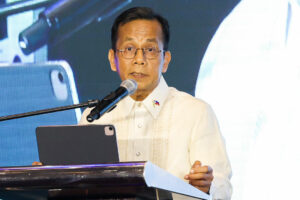THE PHILIPPINES is still on track to become an upper middle-income economy next year as long as the growth momentum continues, National Economic and Development Authority (NEDA) Secretary Arsenio M. Balisacan said.
“If growth this year is not dampened, [we] should be on track,” he told reporters on the sidelines of the BusinessWorld Economic Forum on Wednesday.
The administration of President Ferdinand R. Marcos, Jr. has set a target for the Philippines to reach upper middle-income status by 2025. An upper middle-income country means having a gross national income (GNI) per capita income range of $4,466 to $13,845.
The World Bank currently classifies the Philippines as a lower middle-income country with a GNI per capita of $3,950.
Mr. Balisacan said gross domestic product (GDP) growth must average 6.1% in the next three quarters to hit the government’s 6-7% growth target.
The Philippine economy expanded by 5.7% in the first quarter, slightly faster than 5.5% in the previous quarter.
“There are still three quarters out there. The good thing is inflation is manageable now. Even though we expected worse for the April [print,] it turned out better than expected. So, we hope that will continue,” Mr. Balisacan said.
Inflation accelerated for a third straight month to 3.8% in April from 3.7% in March. Inflation averaged 3.4% in the January-April period, below the central bank’s 3.8% full-year forecast.
In the coming months, NEDA expects economic growth to be favorable as the Bangko Sentral ng Pilipinas (BSP) was “less hawkish” in its last policy meeting and has signaled a possible rate cut in August.
“If the BSP is not going to raise any further the interest rate, and in fact, the governor has indicated that they might start loosening, so that will improve expectations, and expectation drives consumption,” Mr. Balisacan told reporters.
Last week, the Monetary Board kept its target reverse repurchase rate unchanged at a 17-year high of 6.5%.
The waning El Niño dry pattern and expected easing of rice prices may also improve the country’s GDP growth prospects, according to the NEDA chief.
“Since El Niño is tapering, we expect that world prices for commodities, including rice, are expected to moderate and start falling, especially for rice,” Mr. Balisacan said.
Rice inflation, which contributes nearly half to the overall inflation print, accelerated by 23.9% in April. However, this was slower than 24.4% in the previous month.
Security Bank Corp. Chief Economist Robert Dan J. Roces said that achieving upper middle-income status “is not just about hitting a specific threshold, but about building an equitable economy.”
“While the Philippines has made significant progress in recent years, driven by factors such as a young population, a thriving services sector, and increasing foreign investments, it is also crucial that the benefits of economic growth are more evenly distributed,” Mr. Roces said in a Viber message.
To increase its GNI per capita, the country must also ensure competitiveness across all sectors, address infrastructure gaps and challenges, and improve governance in all institutions, Mr. Roces said.
Since 1987, the Philippines has been classified as a lower middle-income economy, according to the World Bank’s earliest records.
“While the Philippines has strong growth prospects that suggest it could reach upper middle-income status in a few years, several challenges — like a potential global economic slowdown, infrastructure and education deficits, and the impact of natural disasters — could impede this goal,” Jonathan L. Ravelas, senior adviser at professional service firm Reyes Tacandong & Co., said in a Viber message.
The World Bank forecasts that the Philippines would be the fastest-growing economy in Southeast Asia this year with a 5.8% growth estimate.
For 2025, the multilateral lender hiked its growth forecast for the Philippines to 5.9% from 5.8%.
However, the World Bank’s growth forecasts for the Philippines still fall behind the government’s 6-7% target band.
During the BusinessWorld Economic Forum, Mr. Balisacan cited the need to “diversify” the country’s growth sources to ensure inclusive and sustainable economic expansion.
“So, what are the growth drivers? We are pushing on all fronts. Opportunities across the entire economy abound in enabling public infrastructure such as energy, water, and physical and digital connectivity, as well as social infrastructure such as schools, healthcare facilities, and housing,” he said.
The government is also looking to expand growth outside the National Capital Region (NCR), he added. — Beatriz Marie D. Cruz





